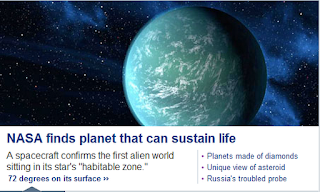 On Dec 6 Yahoo (see image) reported the headline "NASA finds planet that can sustain life". But did they - really? Or is this a case of hype at best or flat out lying at worst on the part of Yahoo?
On Dec 6 Yahoo (see image) reported the headline "NASA finds planet that can sustain life". But did they - really? Or is this a case of hype at best or flat out lying at worst on the part of Yahoo?They say the headline of any article is everything. It determines the level of interest the article will generate. And since we've heard a deluge of stories of planets which "could" or "potentially" or "hopefully" sustain life Yahoo appears to have decided it was time to move to the next level. Now, no matter the real evidence, the "gotcha" headline has become "CAN" sustain life.
But when the reader actually clicks on the article reality does set in and the facts reveal a very different narrative. Not only have they NOT found a planet that CAN sustain life, they are still only in the "hopeful" and "close" stage - the same stage they've been in for decades.
"We are getting very close," Batalha said. "We are homing in on the truly Earth-size, habitable planets."
Homing in? Close? This doesn't sound anything at all like "we found a planet that CAN sustain life". You can read the whole story for yourself here. You will notice that they aren't even sure what kind of sun it is - why? - because if a person traveled at the speed of light it would take 600 years to get there... that's why.
The newfound planet in the habitable zone is called Kepler-22b. It is located about 600 light-years away, orbiting a sun-like star.
Sun... like? Honestly - they have no idea what they're looking at here. They look at a blip in the light traveling toward earth and if it has a solar orbit of one year that means it has a similar distance from the "sun" as we do. The blip means it (the object 600 light years away which Yahoo is saying "CAN" sustain life) has passed through the light from the "sun" and blocked it temporarily. The length of time the light is blocked helps determine the size of the object, etc. That's pretty much all they know about it. They certainly don't know if it "CAN" sustain life. Heck - even saying they're "close" is an enigma.
The real news here is the garbage reporting from Yahoo which does great harm to their credibility. Remember the claims of ET life on an extrasolar planet last year? Readers may recall the outstanding claims and the hype, if only from Creation Ministry's article on the subject, in which one researcher was cited as being “100%” sure that it had life on it. But it’s likely that not many have heard that the existence of Gliese 581g, the planet where this ET life was so certain to exist, has now itself been called into serious question.
A Swiss team presented evidence that suggested Gliese 581g may not even exist. Far from being ‘100% certain’ that life exists on this alleged planet, we don’t even know if Gliese 581g exists at all.


No comments:
Post a Comment